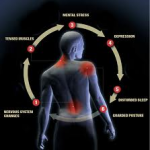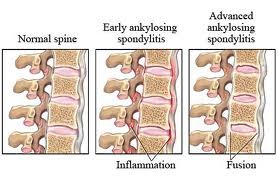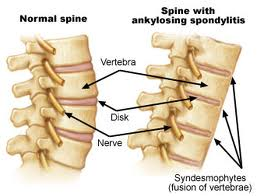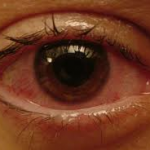It is important to note that the course of ankylosing spondylitis varies greatly from person to person. So too can the onset of symptoms. Although symptoms usually start to appear in late adolescence or early adulthood (ages 17-35), the symptoms can occur in children or much later.
 Typically, the first symptoms of AS are frequent pain and stiffness in the lower back and buttocks, which comes on gradually over the course of a few weeks or months. At first, discomfort may only be felt on one side, or alternate sides. The pain is usually dull and diffuse, rather than localized. This pain and stiffness is usually worse in the mornings and during the night, but may be improved by a warm shower or light exercise. Also, in the early stages of AS, there may be mild fever, loss of appetite and general discomfort. It is important to note that back pain from ankylosing spondylitis is inflammatory in nature and not mechanical.
Typically, the first symptoms of AS are frequent pain and stiffness in the lower back and buttocks, which comes on gradually over the course of a few weeks or months. At first, discomfort may only be felt on one side, or alternate sides. The pain is usually dull and diffuse, rather than localized. This pain and stiffness is usually worse in the mornings and during the night, but may be improved by a warm shower or light exercise. Also, in the early stages of AS, there may be mild fever, loss of appetite and general discomfort. It is important to note that back pain from ankylosing spondylitis is inflammatory in nature and not mechanical.
Inflammatory back pain is the variety associated with ankylosing spondylitis and other spondyloarthritides.
When determing if the back pain is inflammatory in nature and related to a disease such as ankylosing spondylitis, the following is often taken into account:
- Onset of pain is usually under 35 years of age and is insidious
- Pain persists for more than three months (i.e., it is chronic)
- The back pain and stiffness worsen with immobility, especially at night and early morning
- The back pain and stiffness tend to ease with physical activity and exercise
- NSAIDs are very effective in relieving pain and stiffness in most patients
 Note that inflammatory back pain by itself should not be used to diagnose ankylosing spondylitis. Instead it is a very important characteristic which the physician considers along with other findings such as x-ray or MRI evidence of sacroiliitis, the detection of the gene marker HLA B27, or the history of another related physical finding such as Iritis.
Note that inflammatory back pain by itself should not be used to diagnose ankylosing spondylitis. Instead it is a very important characteristic which the physician considers along with other findings such as x-ray or MRI evidence of sacroiliitis, the detection of the gene marker HLA B27, or the history of another related physical finding such as Iritis.
The pain normally becomes persistent (chronic) and is felt on both sides, usually persisting for at least three months. Over the course of months or years, the stiffness and pain can spread up the spine and into the neck. Pain and tenderness spreading to the ribs, shoulder blades, hips, thighs and heels is possible as well.
Note that AS can present differently at onset in women than in men. Quoting Dr. Elaine Adams, “Women often present in a little more atypical fashion so it’s even harder to make the diagnoses in women.” For example, anecdotally we have heard from women with AS who have stated that their symptoms started in the neck rather than in the lower back.
 Varying levels of fatigue may also result from the inflammation caused by AS. The body must expend energy to deal with the inflammation, thus causing fatigue. Also, mild to moderate anemia, which may also result from the inflammation, can contribute to an overall feeling of tiredness.
Varying levels of fatigue may also result from the inflammation caused by AS. The body must expend energy to deal with the inflammation, thus causing fatigue. Also, mild to moderate anemia, which may also result from the inflammation, can contribute to an overall feeling of tiredness.
Other Symptoms
In a minority of individuals, the pain does not start in the lower back, but in a peripheral joint such as the hip, ankle, elbow, knee, heel or shoulder. This pain is commonly caused by enthesitis, which is the inflammation of the site where a ligament or tendon attaches to bone. Inflammation and pain in peripheral joints is more common in juveniles with AS. This can be confusing since, without the immediate presence of back pain, AS may look like some other form of arthritis.
Many people with AS also experience bowel inflammation, which may be associated with Crohn’s Disease or ulcerative colitis.
AS is often accompanied by iritis or uveitis (inflammation of the eyes). About one third of people with AS will experience inflammation of the eye at least once. Signs of iritis or uevitis are: Eye(s) becoming painful, watery, red and individuals may experience blurred vision and sensitivity to bright light.
Advanced Symptoms
Advanced symptoms can be chronic, severe pain and stiffness in the back, spine and possibly peripheral joints, as well as lack of spinal mobility because of chronic inflammation and possible spinal fusion.
Those who have chronic, severe inflammation of the spine can develop a complete bony fusion of the spine (ankylosis). Once fused, the pain in the spine disappears, but the affected individual has a complete loss of spine mobility. These fused spines are particularly brittle and vulnerable to breakage (fracture) when involved in trauma such as motor-vehicle accidents. A sudden onset of pain and mobility in the spinal area of these patients can indicate bone breakage. The lower neck (cervical spine) is the most common area for such fractures.
